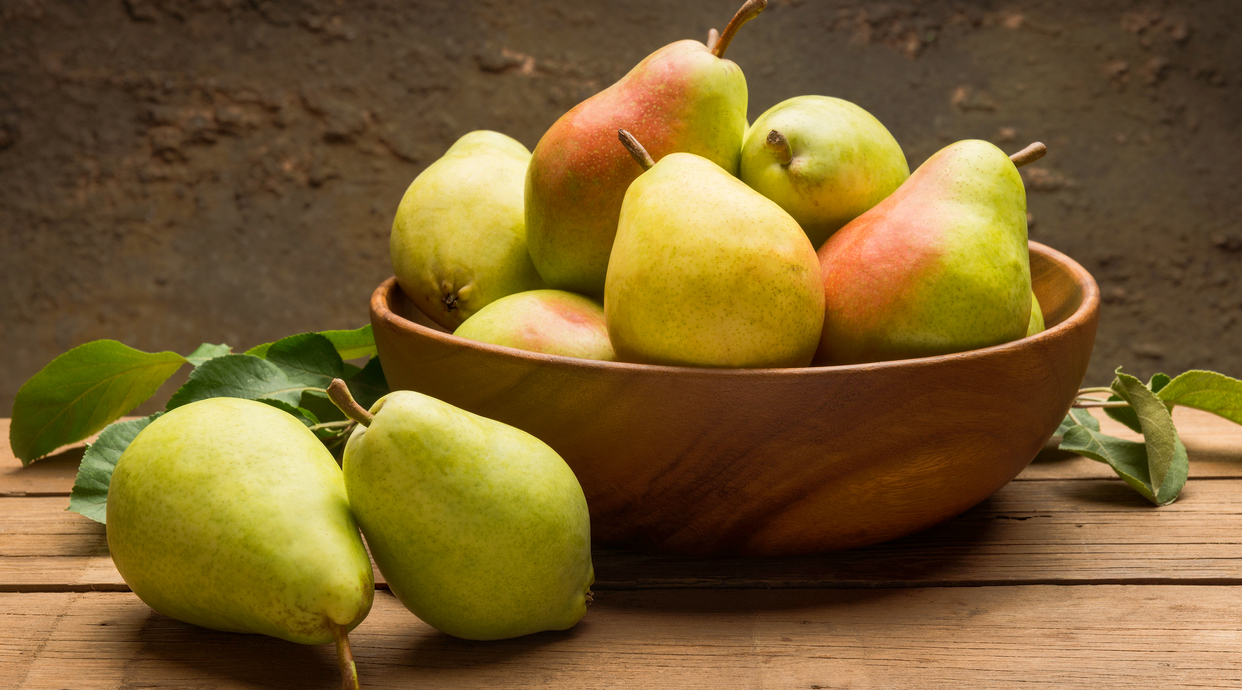Pears

Health Power
Pears give a solid defense against damaging free radicals and are a great source of dietary fiber. Vitamin C and copper help keep highly reactive free radicals from causing oxidative damage to cells all over the body. Vitamin C is water-soluble and defends almost the entire body except areas of fat. It stops free radicals from oxidizing cholesterol into a sticky form that leads to plaque buildup in blood vessels. It also protects white blood cells while they fight off infection and reactivates antioxidant vitamin E. Because vitamin E is fat soluble, by activating it vitamin C helps disarm free radicals in both water-soluble areas and fat-soluble areas. Dietary fiber in pears acts to reduce cholesterol, regulate blood sugar levels and support good digestion.
Vitamin and Mineral Content
Vitamins – C and K
Minerals – Copper and Potassium
Disease Prevention
Reduced risk of colon cancer, postmenopausal breast cancer, heart disease and macular degeneration.
How to Grow
Make sure your pear tree suits your climate. They flower early. If frosts extend well into spring, choose a late-flowering variety. Except for flowering, they are winter hardy. Most cultivars need cross pollination to fruit properly. Plant at least two trees that flower at the same time to get fruit to set. Tree height depends on the cultivar you choose. You can find self-pollinating dwarf trees with three cultivars grafted to one rootstock. This is a good option if space is limited. Best time to plant is early spring. Choose a sunny, sheltered spot with deeper soil. Prepare the soil by amending all around planting area with well-aged compost or planting mix rich in organic matter. Be careful not to over fertilize with nitrogen. This may stimulate too much new growth vulnerable to the deadly fire blight disease. Test the soil to be sure pH is 6-6.5. If not, nutrient deficiencies can cause deformities. Dig a hole wide enough and deep enough to set the bare rooted tree so the existing soil line on the trunk matches up with ground level and roots are unobstructed. A small mound of soil in the center of the hole may help support the tree. Fill the hole with the amended soil and pack it down lightly. Mulch around stem with a thick layer of well-aged manure or compost to ensure nutrient availability. Keep the soil moist by thorough watering. No need to water every day, but make sure to water long enough to reach the root level. (Watering just the surface encourages roots to grow upward.) You can thin out clusters or leave them alone, depending on how big you want fruits to be. If you want large fruit, thin the center fruit in each cluster near mid-summer. With several clusters on a branch, the weight can make a branch break or severely warp. Avoid this by thinning clusters on these branches to one fruit per cluster. Prune thick branches that block sunlight from reaching the foliage. Each spring, spread a thin layer of organic fertilizer and mulch over the roots. Pears take 2 or more years to bear fruit. Harvest fruit when it easily detaches with a slight tug. Store in cool temperatures. Bring up to room temperature before eating to soften and sweeten them up.
Insect Control
Pear tree pests are aphids, wooly aphids, winter moth, coddling moth, sawfly and wasps. Fire blight is the most common disease. Remove aphids with a strong water stream. Also, draw their predators (hoverflies and ladybugs) by planting French marigolds nearby. Wooly aphids are more difficult to remove. They form colonies on branches and cover themselves with a white waxy substance. Scrape off as soon as you see them. Or spray with rotenone after petals fall. If that does not work, cut them out. You can stop female winter moth caterpillars from breeding on the lower trunk by securing a sticky ring around the tree to catch them as they crawl up to lay eggs. Coddling moths lay eggs that hatch into fruit maggots. Deter them with a pheromone trap hung from a branch. (Find at your local nursery.) Sawfly quickly eat leaves off. Spray with an insecticide when you see caterpillars on leaves. If wasps are a problem, make a trap by putting sweet liquid in a container covered with a thin layer that has a hole in it. Hang this from the tree. Wasps will enter the container and be trapped. For fire blight, find out if your area is susceptible and buy a resistant cultivar. Otherwise, don’t prune too much as new soft growth is most susceptible.
Tips
When fruit stops growing and starts changing color, stop watering to keep the tree free of diseases. Pear trees grow tall but can be easier to harvest if shaped correctly.





